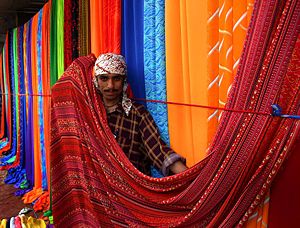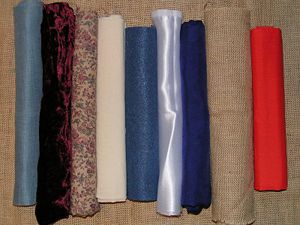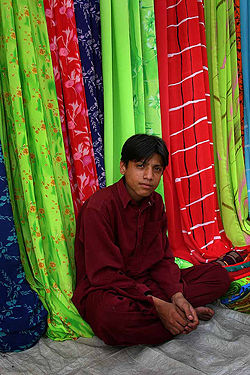Textile
- For other uses, see Textile (disambiguation).
A textile is a flexible material comprised of a network of natural or artificial fibres often referred to as thread or yarn. [1] Textiles are formed by weaving, knitting, crocheting, knotting, or pressing fibres together.
Terminology
The words fabric and cloth are commonly used in textile assembly trades (such as tailoring and dressmaking) as synonyms for textile. However, there are subtle differences in these terms. Textile refers to any material made of interlacing fibres. Fabric refers to any material made through weaving, knitting, crocheting, or pressing. Cloth refers to a finished piece of fabric that can be used for a purpose such as covering a bed or table.
History
The production of textiles is an ancient craft, whose speed and scale of production has been altered almost beyond recognition by industrialization and the introduction of modern manufacturing techniques. However, there is little difference between ancient and modern plain weave, twill or satin.
Many textiles have been in use for millennia, while others are recent inventions. The range of materials has increased in the last century with the introduction of artificial fibers in the 1920s and 1930s.
Uses
Textiles have an assortment of uses, the most common of which are for clothing and containers such as bags and baskets. In the household, it is used in carpeting, upholstered furnishings, towels, covering for tables, beds, and other flat surfaces, and in art. In the workplace, it is used in industrial and scientific processes such as filtering. Miscellaneous uses include flags, tents, nets, cleaning devices, and transportation devices such as balloons, kites, sails, and parachutes.
Textiles used for industrial purposes, and chosen for characteristics other than their appearance, are commonly referred to as technical textiles.
Sources and types
Textiles can be made from many materials. These materials come from four main sources: animal, plant, mineral, and synthetic. In the past, all textiles were made from natural fibres, including plant, animal, and mineral sources. In the 20th century, these were supplemented by artificial fibres made from petroleum.
Textiles are made in various strengths and degrees of durability, from the finest gossamer to the sturdiest canvas. The relative thickness of fibres in cloth is measured in deniers. Microfiber refers to fibers made of strands thinner than one denier.
Animal textiles
Animal textiles are commonly made from hair or fur.
Wool refers to the hair of the domestic goat or sheep, which is distinguished from other types of animal hair in that the individual strands are coated with scales and tightly crimped, and the wool as a whole is coated with an oil known as lanolin, which is waterproof and dirtproof. Woollen refers to raw wool, while worsted refers to the yarn which is spun from this. Wool is commonly used for warm clothing. Cashmere, the hair of the Indian cashmere goat, and mohair, the hair of the North African angora goat, are types of wool known for their softness.
Other animal textiles which are made from hair or fur are alpaca wool, vicuña wool, llama wool, and camel hair, generally used in the production of coats, jackets, ponchos, blankets, and other warm coverings. Angora refers to the long, thick, soft hair of the angora rabbit.
Silk is an animal textile made from the fibers of the cocoon of the Chinese silkworm. This is spun into a smooth, shiny fabric prized for its sleek texture.
Plant textiles
Grass, rush, hemp, and sisal are all used in making rope. In the first two, the entire plant is used for this purpose, while in the last two, only fibers from the plant are utilized. Coir (coconut fiber) is used in making twine, and also in floormats, doormats, brushes, mattresses, floor tiles, and sacking.
Straw and bamboo are both used to make hats. Straw, a dried form of grass, is also used for stuffing, as is kapok.
Fibres from pulpwood trees, cotton, rice, hemp, and nettle are used in making paper.
Cotton, flax, jute, and modal are all used in clothing. Piña (pineapple fiber) and ramie are also fibres used in clothing, generally with a blend of other fabrics such as cotton.
Acetate is used to increase the shininess of certain fabrics such as silks, velvets, and taffetas.
Seaweed is used in the production of textiles. A water-soluble fiber known as alginate is produced and is used as a holding fiber; when the cloth is finished, the alginate is dissolved, leaving an open area.
Mineral textiles
Asbestos and basalt fiber are used for vinyl tiles, sheeting, and adhesives, "transite" panels and siding, acoustical ceilings, stage curtains, and fire blankets.
Glass fiber is used in the production of spacesuits, ironing board and mattress covers, ropes and cables, reinforcement fiber for motorized vehicles, insect netting, flame-retardant and protective fabric, soundproof, fireproof, and insulating fibers.
Metal fiber, metal foil, and metal wire have a variety of uses, including the production of cloth-of-gold and jewelry.
Synthetic textiles
All synthetic textiles are used primarily in the production of clothing.
Polyester fiber is used in all types of clothing, either alone or blended with fibres such as cotton.
Acrylic is a fibre used to imitate wools, including cashmere, and is often used in replacement of them.
Nylon is a fibre used to imitate silk and is tight-fitting; it is used in the production of pantyhose.
Lycra, spandex, and tactel are fibres that stretch easily and are also tight-fitting, and are used to make activewear, bras, and swimsuits.
Olefin fiber is a thermal fiber used in activewear, linings, and warm clothing.
Lurex is a metallic fiber used in clothing embellishment.
Ingeo is a fiber blended with other fibres such as cotton and used in clothing. It is prized for its ability to wick away perspiration.
Production methods
Weaving is a textile production method which involves interlacing a set of vertical threads (called the warp) with a set of horizontal threads (called the weft). This is done on a machine known as a loom, of which there are a number of types. Some weaving is still done by hand, but the vast majority is mechanised.
Knitting and crocheting involve interlacing loops of yarn, which are formed either on a knitting needle or on a crochet hook, together in a line. The two processes are different in that knitting has several active loops at one time, on the knitting needle waiting to interlock with another loop, while crocheting never has more than one active loop on the needle.
Braiding or plaiting involves twisting threads together into cloth. Knotting involves tying threads together and is used in making macrame.
Lace is made by interlocking threads together independently, using a backing and any of the methods described above, to create a fine fabric with open holes in the work. Lace can be made by either hand or machine.
Carpets, rugs, velvet, velour, and velveteen, are made by interlacing a secondary yarn through woven cloth, creating a tufted layer known as a nap or pile.
Treatments
Textiles are often dyed, with fabrics available in almost every color. Coloured designs in textiles can be created by weaving together fibres of different colours (plaid), adding coloured stitches to finished fabric (embroidery), creating patterns by tying off areas of cloth and dyeing the rest (tie-dye, or drawing wax designs on cloth and dyeing in between them (batik), or using various printing processes on finished fabric.
Textiles are also sometimes bleached. In this process, the original colour of the textile is removed by chemicals or exposure to sunlight, turning the textile pale or white.
Textiles are sometimes finished by starching, which makes the fabric stiff and less prone to wrinkles, or by waterproofing, which makes the fabric slick and impervious to water or other liquids. Since the 1990s, finishing agents have been used to strengthen fabrics and make them wrinkle free. [1]
See also
- Manufacturing
- Textile manufacturing terminology
- Timeline of clothing and textiles technology
ReferencesISBN links support NWE through referral fees
- ↑ An Introduction to Textile Terms (pdf). The Textile Museum. Retrieved August 6, 2006.
External links
Credits
New World Encyclopedia writers and editors rewrote and completed the Wikipedia article in accordance with New World Encyclopedia standards. This article abides by terms of the Creative Commons CC-by-sa 3.0 License (CC-by-sa), which may be used and disseminated with proper attribution. Credit is due under the terms of this license that can reference both the New World Encyclopedia contributors and the selfless volunteer contributors of the Wikimedia Foundation. To cite this article click here for a list of acceptable citing formats.The history of earlier contributions by wikipedians is accessible to researchers here:
The history of this article since it was imported to New World Encyclopedia:
Note: Some restrictions may apply to use of individual images which are separately licensed.


